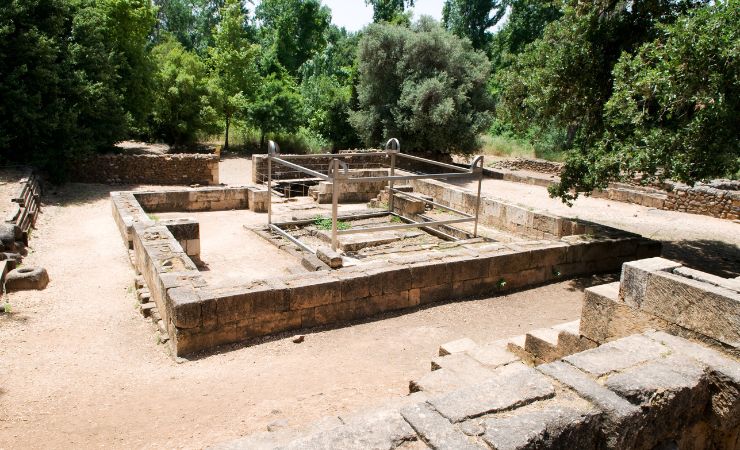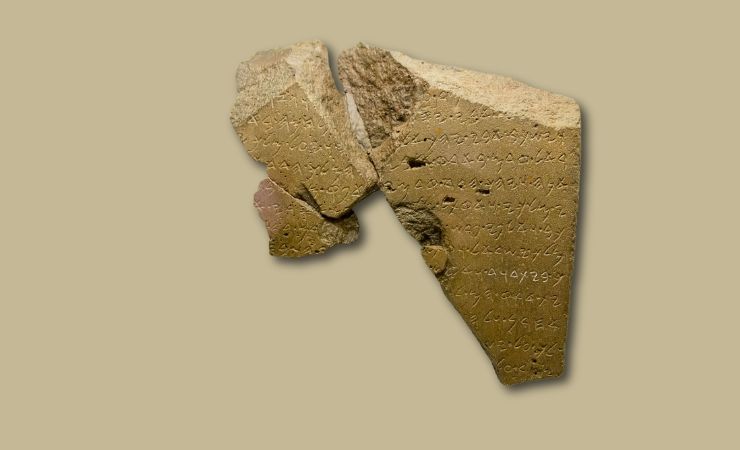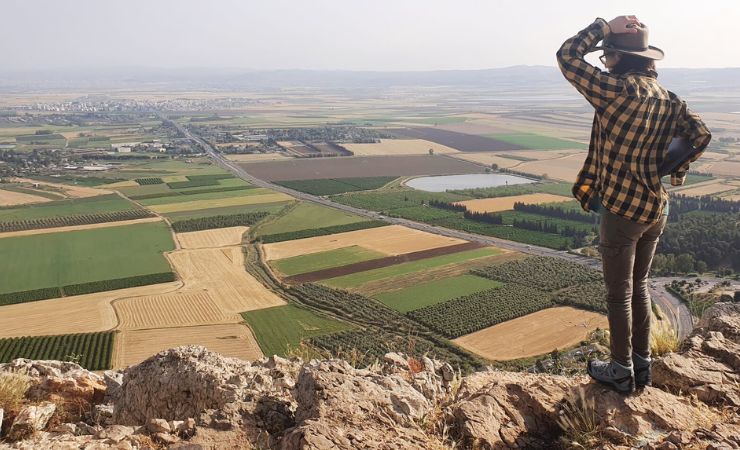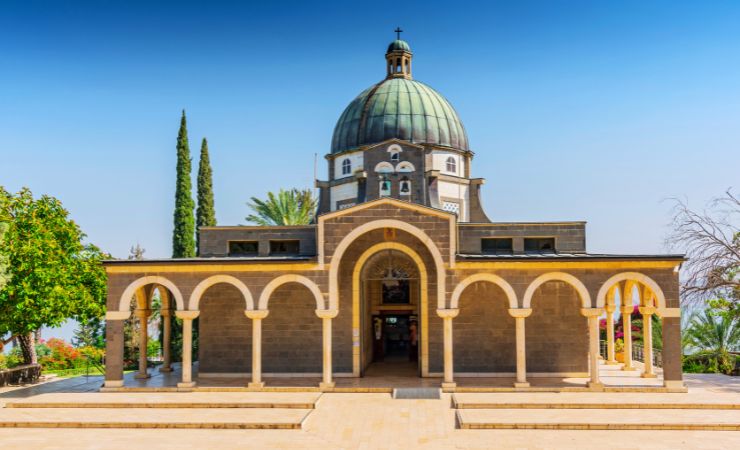Tel Dan: From Abraham to the Unearthing of David
Tel Dan, known in Arabic as Tell el-Qāḍī, stands as a significant archaeological site in northern Israel, holding a rich history that spans from the Neolithic period to the Roman era. Tel Dan has been identified with the biblical city of Dan, and before that, the Canaanite city of Laish.

Location
Tel Dan occupies a rectangular mound in the northeastern part of the Hula Valley, at the foot of Mount Hermon. This location marks the source of the Dan River, the largest tributary of the Jordan River.
The History of Tel Dan
The earliest human activity at Tel Dan dates back to the Neolithic era, around 5000 BCE, marking it as one of the oldest known settlements in the region. During the Middle Bronze Age (circa 1900–1500 BCE), the city, then known as Laish, emerged as a fortified Canaanite urban center. Notably, archaeologists uncovered a well-preserved mudbrick gate with three arches, considered one of the earliest complete standing arches globally. Laish is mentioned in ancient Egyptian records, including the conquest list of Pharaoh Thutmose III in the 15th century BCE, underscoring its prominence in the ancient Near East.
According to the biblical narrative in Judges 18, the Israelite tribe of Dan, seeking new territory, migrated northward and captured Laish, renaming it Dan in honor of their ancestor. This event is dated to around the 12th century BCE. Archaeological evidence supports a significant cultural shift during this period, indicating a transition from Canaanite to Israelite occupation.
Under Israelite control, Tel Dan became a vital city within the northern kingdom. King Jeroboam I established a cultic center there, erecting a golden calf to prevent his subjects from traveling to Jerusalem for worship, as detailed in 1 Kings 12:28–30.
Biblical Context
Tel Dan holds considerable importance within the biblical narrative, frequently referenced in contexts that illustrate its religious, strategic, and political roles within ancient Israel. The city of Dan is mentioned 21 times in the Hebrew Bible: Genesis (once), Joshua (once), Judges (twice), First Samuel (once), Second Samuel (5 times), First Kings (4 times), Second Kings (once), First Chronicles (once), Second Chronicles (twice), Jeremiah (twice), and Amos (once). Here are a few examples:
Abraham and the Pursuit to Dan
Tel Dan first appears in the Bible as the northernmost landmark reached by Abraham during his pursuit of kings who had kidnapped his nephew Lot:
“When Abram heard that his relative had been taken captive, he called out the 318 trained men born in his household and went in pursuit as far as Dan.” (Genesis 14:14, NIV)
This biblical reference indicates Tel Dan’s strategic location as a known geographic boundary of early Canaan.
Conquest by the Tribe of Dan
Originally known as Laish, the site was conquered by the tribe of Dan after migrating from their initial territory in the south. The narrative emphasizes the city’s peaceful nature and isolation before its capture:
“Then they took what Micah had made, and his priest, and went on to Laish, against a people at peace and secure. They attacked them with the sword and burned down their city… They rebuilt the city and settled there. They named it Dan after their ancestor Dan, who was born to Israel—though the city used to be called Laish.” (Judges 18:27-29, NIV)
This marked a significant shift as the tribe of Dan firmly established itself in the region, renaming the site after their patriarch.
Jeroboam’s Golden Calves
The religious significance of Tel Dan was cemented when Jeroboam I, king of the Northern Kingdom of Israel, erected one of two golden calves to deter his people from making pilgrimages to Jerusalem:
“After seeking advice, the king made two golden calves. He said to the people, ‘It is too much for you to go up to Jerusalem. Here are your gods, Israel, who brought you up out of Egypt.’ One he set up in Bethel, and the other in Dan. And this thing became a sin…” (1 Kings 12:28-30, NIV)
This event transformed Tel Dan into a prominent religious site, albeit controversial, illustrating the political and spiritual tensions of ancient Israel.
Prophetic Condemnations
The establishment of the calf cult at Dan drew criticism from the prophets, notably Amos, who denounced the practices at Dan and predicted divine judgment against such idolatry:
“Those who swear by the sin of Samaria—who say, ‘As surely as your god lives, Dan,’… they will fall, never to rise again.” (Amos 8:14, NIV)




Excavation History and Archeological Findings
Excavation History
Archaeological interest in Tell el-Qāḍī, identified as biblical Dan in 1838 by American scholar Edward Robinson, began in the 19th century. However, systematic excavations did not commence until 1966. These excavations were initially undertaken as a rescue operation by the Israel Department of Antiquities and Museums under the direction of Avraham Biran. In 1974, Biran moved to the Hebrew Union College, bringing the Tel Dan project under the auspices of the Nelson Glueck School of Biblical Archaeology.
Biran led 33 seasons of excavations at the site, from 1966 until the end of the 1990s. Over these years, seven areas were excavated on the mound, primarily along its perimeter. While numerous preliminary reports and articles have been published by Biran, the final reports for the Iron Age II period are still awaited. Nevertheless, the extensive excavations have revealed a wealth of information about the city’s long history.
Archaeological Finds
The excavations at Tel Dan have unearthed significant remains from various periods, attesting to its importance over millennia. Key archaeological discoveries include:
- Massive Bronze Age Ramparts: Evidence of substantial fortifications dating back to the Middle Bronze Age.
- Intact Mud-Brick Gate of the Middle Bronze Age: Featuring three complete arches, this impressive structure dates to the 18th-19th century BCE and is considered one of the oldest arches in the world, predating Roman invention by 2000 years. It is popularly referred to as “Abraham’s Gate”.
- Middle Bronze Age Tombs and Burials: Providing insights into burial practices and material culture of the period.
- Late Bronze Age “Mycenaean Tomb”: Indicating connections to the Aegean world.
- Rich Stratum of the Early Iron Age: Associated with the Israelite Settlement, yielding grain pits, numerous ceramic vessels, metallurgical activity, and domestic architecture.
- Sacred Precinct (High Place): Dating to the Iron Age II, this area suggests Dan’s role as a significant religious center. Excavations revealed the cultic enclosure, with evidence of different phases of construction and use during the Iron Age II and Hellenistic periods. A Hellenistic Greek-Aramaic/Hebrew stela mentioning “the god who is in Dan” was found within this enclosure, further supporting the site’s identification.
- Series of Gate Complexes Dating to the Iron Age II: Particularly massive fortification systems reflecting the city’s strategic importance during the 9th and 8th centuries BCE. Cultic objects were also found in the gate area, suggesting a religious significance to these structures.
- Iron Age Inscriptions on Vessels: Eight Iron Age inscriptions have been discovered on vessels, providing evidence of literacy and the use of Hebrew and Aramaic at Tel Dan. Some of these inscriptions contain personal names, some with potential Yahwistic elements, and possible Phoenician influences.
- Assyrian Residence: Evidence of Assyrian presence and administration at Tel Dan following its probable conquest in the late 8th century BCE.

The Tel Dan Stele and the Mention of David
One of the most remarkable discoveries at Tel Dan is the Tel Dan Stele, a fragmentary basalt slab containing an Aramaic inscription. The main fragment was found in 1993 by Gila Cook, embedded in an 8th-century BCE wall bordering a piazza outside the outer gate in Area A. If was located while completing measurements at Tel Dan, the narrator discovered ancient Hebrew or Phoenician letters on a partially buried stone. Avraham Biran, the excavation director, impatiently urged him to finish work quickly and leave. When shown the inscription, Biran initially struggled to see it clearly. Realizing its profound archaeological significance, Biran quietly exclaimed in perfect English, “Oh my God!” Two smaller fragments were discovered in 1994.
The inscription, generally dated to the second half of the 9th century BCE, is believed by many scholars to have been erected by the Aramaean king Hazael of Damascus. The text boasts of victories over the “king of Israel” and the “king of the House of David”.
The mention of “bytdwd” (ביתדוד), or “House of David,” in line 9 of the main fragment has generated intense scholarly debate. The initial interpretation by the excavators, Avraham Biran and Joseph Naveh, identified this as a reference to the biblical dynasty of David. This interpretation is supported by many archaeologists and biblical scholars and is considered by some as the first historical evidence of King David outside of the Hebrew Bible.
However, this reading has faced skepticism, with some scholars suggesting alternative interpretations of “bytdwd,” such as a place name or a deity. Despite these debates, the prevailing view among many is that the Tel Dan Stele provides nearly contemporary corroboration for the existence of King David and his dynasty in the 9th century BCE. The stele’s shattering is thought to have occurred during the first half of the 8th century BCE, possibly signifying the recapture of Tel Dan by the Kingdom of Israel.
Additional Information
Pre-Iron Age:
- c. 7000 years ago: First settlement at Tel Dan.
- c. 2700 BCE: The first city is established at Tel Dan (initially known as Laish or Leshem).
- c. 1750-1550 BCE (Middle Bronze Age II B-C): The Canaanite city of Laish is well-fortified with an earthen rampart (10-15 meters high with a stone core) and a mud-brick arched gate (“Gate of Three Arches”). The city enjoys trade with Mesopotamia and Sidon and is mentioned in Egyptian Execration Texts and Mari documents as a source of tin.
- Mid-15th Century BCE (Late Bronze Age I): Thutmose III of Egypt conquers Laish. Mycenaean culture influences are present, including a Mycenaean tomb.
- 13th Century BCE (Late Bronze Age II B): A smaller settlement exists.
- 12th Century BCE (Iron Age IA): Granary pits and metalworking indicate a developing copper industry, possibly linked to early Israelite settlement. Philistine pottery is also found.
- 11th Century BCE (Iron Age IA): Destruction layer.
Iron Age:
- 10th Century BCE (Iron Age IB – Iron Age IIA): After the Israelite conquest, the tribe of Dan, having trouble in the south with the Philistines, migrates north, conquers Laish, and renames it Dan after their ancestor. Jeroboam I, the first king of the Northern Kingdom of Israel after the split from Judah, builds cultic sites in Bethel and Dan, including placing one of the two golden bulls in Dan to rival Jerusalem as a religious center.
- 9th Century BCE (Iron Age IIB):Ben-Hadad I of Aram Damascus is bribed by Asa, King of Judah, to break his alliance with Baasha, King of Israel, and attacks Israelite cities, including Ijon and Dan.
- Ahab, King of Israel, expands the cultic complex at Dan.
- The Tel Dan Stele is erected by an Aramean king, likely Hazael of Aram Damascus, commemorating a victory over the Kingdom of Israel. The stele mentions the killing of Joram, King of Israel, and Ahaziah, King of the “House of David” (Kingdom of Judah). This event aligns with the biblical account of Jehu’s revolt, although the stele attributes the killings to the Aramean king.
- Early 8th Century BCE (Iron Age IIB):Jeroboam II, King of Israel, adds steps to the cultic platform at Dan.
- The Tel Dan Stele is likely destroyed and its fragments used as building material, possibly by Jehoash, King of Israel, who fought against Aram and recaptured cities taken by Hazael.
- c. 750 BCE (Iron Age II C): Tel Dan is destroyed by a large fire, likely during the Assyrian conquest.
- 733/732 BCE: Tiglath-Pileser III of Assyria conquers the Northern Kingdom of Israel. While Abraham Biran suggested this as the end of Dan, there is no direct biblical or Assyrian record of Dan’s destruction at this time.
- Late 8th Century BCE (Iron Age IIB): Level associated with the Assyrian conquest contains a room of altars, bronze and silver scepter head, and Paleo-Hebrew, Phoenician, and Aramaic inscriptions.
- Late 8th/7th Century BCE (Iron Age II C): Destruction layer associated with the Babylonian destruction.
Post-Iron Age:
- Persian-Hellenistic Period (4th-1st Centuries BCE): The cultic site at Dan is revived. A bilingual (Greek and Aramaic) inscription “To the god who is in Dan” testifies to its continued religious importance.
- Roman Period (1st-4th Centuries CE): Dan is conquered during the revolt against the Romans and subsequently destroyed, leading to its abandonment. The main settlement shifts to Banias.
- Mamluk and Early Ottoman Periods (15th-16th Centuries CE): Possible farmstead or small village exists at the site, with remains of a small cemetery found.
- 1917: Arthur Hjelt visits Tell el-Kadi (Tel Dan) and describes its abundant water source and lush vegetation, recognizing its potential for archaeological excavation and hoping for a Finnish expedition. World War I interrupts his plans.
- 1963: A brief test excavation is conducted by Z. Yeivin on behalf of the Department of Antiquities and Museums.
- 1966 onwards: Extensive archaeological excavations begin at Tel Dan, primarily led by Abraham Biran, initially for the Department of Antiquities and Museums and later for the Nelson Glueck School of Biblical Archaeology of Hebrew Union College-Jerusalem. Over 33 seasons of excavation take place.
- 1979: The Canaanite arched gate is discovered.
- July 21, 1993: Gila Cook, a surveyor for the excavation team, discovers the first fragment (A) of the Tel Dan Stele.
- 1994: Two more fragments (B1 and B2) of the Tel Dan Stele are discovered by the excavation team led by Abraham Biran in the gate area.
- Since the late 20th Century: The Tel Dan Stele is displayed at the Israel Museum in Jerusalem.
- 2001: The Israel Nature and Parks Authority, with assistance from the World Monuments Watch, erects a shelter over the Canaanite gate to protect it.
Nearby Sites
- Banias Nature Reserve (Caesarea Philippi) – A lush nature reserve featuring scenic waterfalls, ancient ruins, and the famous grotto associated with the Greek god Pan.
- Nimrod Fortress – A medieval Crusader-era fortress perched dramatically atop the Golan Heights, offering spectacular panoramic views.
- Mount Hermon – Israel’s highest peak, popular for hiking in summer and skiing in winter, providing breathtaking landscapes year-round.
- Hula Valley Nature Reserve – Renowned for birdwatching, this reserve hosts thousands of migrating birds, including cranes, pelicans, and storks.



